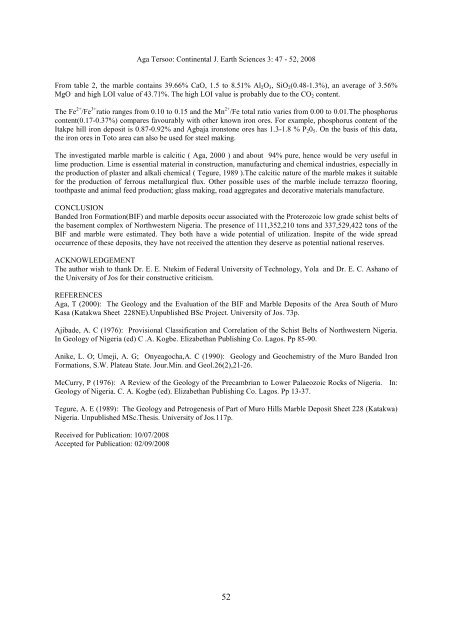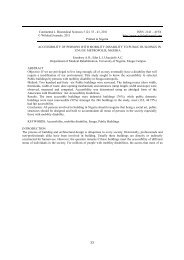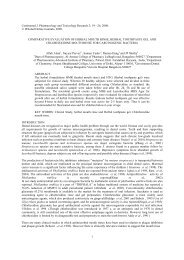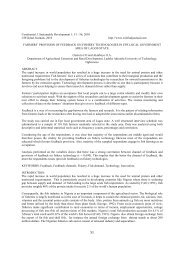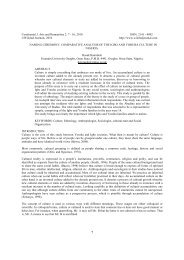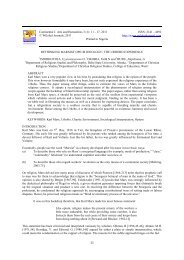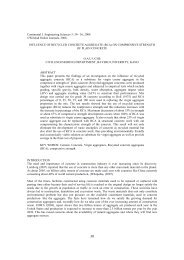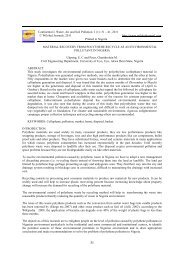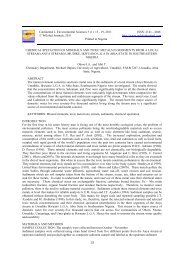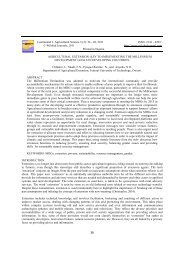Continental J. Earth Sciences 3: 47 - 52, 2008 ... - Wilolud Journals
Continental J. Earth Sciences 3: 47 - 52, 2008 ... - Wilolud Journals
Continental J. Earth Sciences 3: 47 - 52, 2008 ... - Wilolud Journals
Create successful ePaper yourself
Turn your PDF publications into a flip-book with our unique Google optimized e-Paper software.
Aga Tersoo: <strong>Continental</strong> J. <strong>Earth</strong> <strong>Sciences</strong> 3: <strong>47</strong> - <strong>52</strong>, <strong>2008</strong>From table 2, the marble contains 39.66% CaO, 1.5 to 8.51% Al 2 O 3 , SiO 2 (0.48-1.3%), an average of 3.56%MgO and high LOI value of 43.71%. The high LOI value is probably due to the CO 2 content.The Fe 2+ /Fe 3+ ratio ranges from 0.10 to 0.15 and the Mn 2+ /Fe total ratio varies from 0.00 to 0.01.The phosphoruscontent(0.17-0.37%) compares favourably with other known iron ores. For example, phosphorus content of theItakpe hill iron deposit is 0.87-0.92% and Agbaja ironstone ores has 1.3-1.8 % P 2 0 5 . On the basis of this data,the iron ores in Toto area can also be used for steel making.The investigated marble marble is calcitic ( Aga, 2000 ) and about 94% pure, hence would be very useful inlime production. Lime is essential material in construction, manufacturing and chemical industries, especially inthe production of plaster and alkali chemical ( Tegure, 1989 ).The calcitic nature of the marble makes it suitablefor the production of ferrous metallurgical flux. Other possible uses of the marble include terrazzo flooring,toothpaste and animal feed production; glass making, road aggregates and decorative materials manufacture.CONCLUSIONBanded Iron Formation(BIF) and marble deposits occur associated with the Proterozoic low grade schist belts ofthe basement complex of Northwestern Nigeria. The presence of 111,3<strong>52</strong>,210 tons and 337,<strong>52</strong>9,422 tons of theBIF and marble were estimated. They both have a wide potential of utilization. Inspite of the wide spreadoccurrence of these deposits, they have not received the attention they deserve as potential national reserves.ACKNOWLEDGEMENTThe author wish to thank Dr. E. E. Ntekim of Federal University of Technology, Yola and Dr. E. C. Ashano ofthe University of Jos for their constructive criticism.REFERENCESAga, T (2000): The Geology and the Evaluation of the BIF and Marble Deposits of the Area South of MuroKasa (Katakwa Sheet 228NE).Unpublished BSc Project. University of Jos. 73p.Ajibade, A. C (1976): Provisional Classification and Correlation of the Schist Belts of Northwestern Nigeria.In Geology of Nigeria (ed) C .A. Kogbe. Elizabethan Publishing Co. Lagos. Pp 85-90.Anike, L. O; Umeji, A. G; Onyeagocha,A. C (1990): Geology and Geochemistry of the Muro Banded IronFormations, S.W. Plateau State. Jour.Min. and Geol.26(2),21-26.McCurry, P (1976): A Review of the Geology of the Precambrian to Lower Palaeozoic Rocks of Nigeria. In:Geology of Nigeria. C. A. Kogbe (ed). Elizabethan Publishing Co. Lagos. Pp 13-37.Tegure, A. E (1989): The Geology and Petrogenesis of Part of Muro Hills Marble Deposit Sheet 228 (Katakwa)Nigeria. Unpublished MSc.Thesis. University of Jos.117p.Received for Publication: 10/07/<strong>2008</strong>Accepted for Publication: 02/09/<strong>2008</strong><strong>52</strong>


